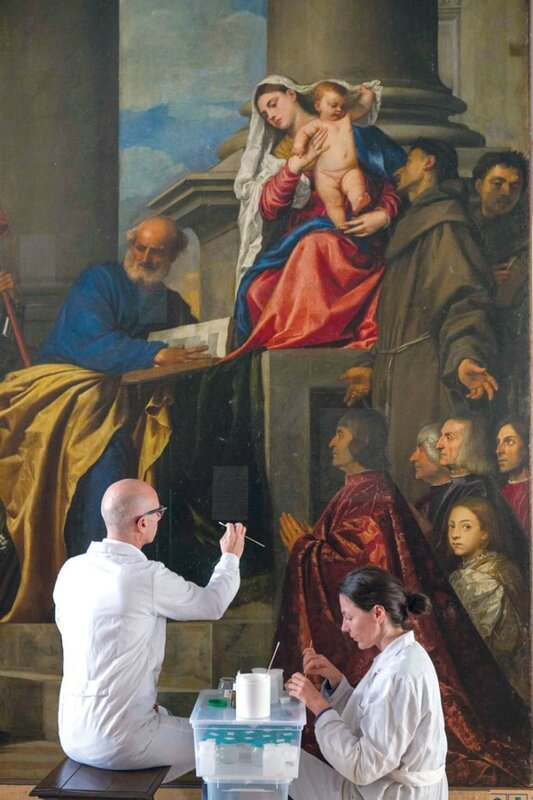6 décembre 2017
Save Venice Inc. restores Titian's Madonna di Ca' Pesaro
Titian, Madonna di Ca’ Pesaro, After Restoration, 1519–1526. Church of Santa Maria Gloriosa dei Frari, Venice. Photo by Matteo de Fina.
VENICE.- Titian’s famed Madonna di Ca' Pesaro can once again be admired by visitors to the church of Santa Maria Gloriosa dei Frari in Venice following a painstaking four-year conservation treatment funded by the American nonprofit organization Save Venice Inc. with major support from The Thompson Family Foundation, Inc. and The Leona M. and Harry B. Helmsley Charitable Trust. The restoration campaign for the monumental altarpiece successfully addressed the grave instability of the painted surface layer, which in many areas had cracked, bubbled, and even completely flaked away. This condition had plagued Titian's masterpiece for at least the last two centuries and threatened the permanent loss of the artist's exquisite figures, details, and colors.
The success of the restoration is owed to a team of conservators led by Giulio Bono and Italy's top restoration chemists, expert photographers and imaging technicians, specialized art handlers, and officials from the Italian Ministry of Culture.
New advances in conservation technologies and techniques allowed conservators to identify the factors that caused the underlying flaking problem: extensive exposure to high humidity levels, drastic fluctuations in humidity and temperature, and the presence of harmful surface residues that had accumulated from previous restoration attempts. These issues were treated using minimallyinvasive methods and materials with innovative solvents and micro-integrations of sturgeon glue. To protect the fragile artwork for centuries to come, a sophisticated tension system was added to the painting's stretcher and a special barrier layer was installed on the back of the painting.
On September 21, 2017, more than 400 people gathered in the Frari to celebrate the return of Titian’s restored altarpiece to its original location. Remarks were given by parish priest Padre Lino Pellanda, Superintendent Emanuela Carpani, Project Director Giulio Manieri Elia, and Save Venice Board member Alberto Nardi.
The success of the restoration is owed to a team of conservators led by Giulio Bono and Italy's top restoration chemists, expert photographers and imaging technicians, specialized art handlers, and officials from the Italian Ministry of Culture.
New advances in conservation technologies and techniques allowed conservators to identify the factors that caused the underlying flaking problem: extensive exposure to high humidity levels, drastic fluctuations in humidity and temperature, and the presence of harmful surface residues that had accumulated from previous restoration attempts. These issues were treated using minimallyinvasive methods and materials with innovative solvents and micro-integrations of sturgeon glue. To protect the fragile artwork for centuries to come, a sophisticated tension system was added to the painting's stretcher and a special barrier layer was installed on the back of the painting.
On September 21, 2017, more than 400 people gathered in the Frari to celebrate the return of Titian’s restored altarpiece to its original location. Remarks were given by parish priest Padre Lino Pellanda, Superintendent Emanuela Carpani, Project Director Giulio Manieri Elia, and Save Venice Board member Alberto Nardi.
Titian, Madonna di Ca’ Pesaro, After Restoration, 1519–1526. Church of Santa Maria Gloriosa dei Frari, Venice. © DR
Titian, c.1485-1576, Madonna di Ca’ Pesaro, before restauration, 1519–1526, Oil on canvas. Church of Santa Maria Gloriosa dei Frari, San Polo. © Save Venice inc.
Titian, c.1485-1576, Madonna di Ca’ Pesaro, in restauration, 1519–1526, Oil on canvas. Church of Santa Maria Gloriosa dei Frari, San Polo. © Save Venice inc.
Titian, c.1485-1576, Madonna di Ca’ Pesaro, in restauration, 1519–1526, Oil on canvas. Church of Santa Maria Gloriosa dei Frari, San Polo. © Save Venice inc.
Publicité
Publicité
Commentaires

/https%3A%2F%2Fprofilepics.canalblog.com%2Fprofilepics%2F1%2F0%2F100183.jpg)
/https%3A%2F%2Fstorage.canalblog.com%2F03%2F02%2F119589%2F96711876_o.jpg)
/https%3A%2F%2Fstorage.canalblog.com%2F11%2F31%2F119589%2F94773502_o.jpg)
/https%3A%2F%2Fstorage.canalblog.com%2F20%2F83%2F119589%2F94772815_o.jpg)
/https%3A%2F%2Fstorage.canalblog.com%2F26%2F72%2F119589%2F75604929_o.jpg)
/https%3A%2F%2Fstorage.canalblog.com%2F59%2F60%2F119589%2F26458628_o.jpg)







/image%2F1371349%2F20240412%2Fob_258f9b_ash-ashm-wa2008-89-001.jpg)
/image%2F1371349%2F20240412%2Fob_d5ebdf_10105187116-db17b2f5ff-b.jpg)
/image%2F1371349%2F20240412%2Fob_efd409_dp811857.jpg)
/http%3A%2F%2Fstorage.canalblog.com%2F04%2F81%2F119589%2F128791640_o.jpg)